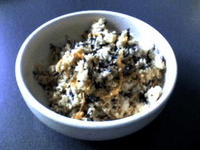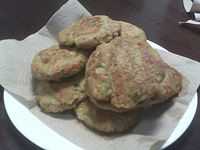Okara (food)
| Okara | |||||||
.jpg) Filtering okara from a fresh batch of homemade soymilk. | |||||||
| Korean name | |||||||
|---|---|---|---|---|---|---|---|
| Hangul | 비지 or 콩비지 | ||||||
| |||||||
| Chinese name | |||||||
| Chinese | 雪花菜, 豆渣 or 豆腐渣 | ||||||
| |||||||
Okara or Soy Pulp is a pulp consisting of insoluble parts of the soybean[1] which remains after pureed soybeans are filtered in the production of soy milk and tofu.[2] It is generally white or yellowish in color. It is part of the traditional cuisines of Japan, Korea, and China, and since the 20th century has also been used in the vegetarian cuisines of Western nations.
Okara is the oldest of three basic types of soy fiber. The other two are soy bran (finely ground soybean hulls), and soy cotyledon/isolate fiber (the fiber that remains after making isolated soy protein, also called "soy protein isolate").
History
1621 - In the Qunfang Pu [The assembly of perfumes, or Monographs on cultivated plants], Wang Xiangjin, of China,after discussing tofu, remarks that the residue (zhi, Jap: okara) from the tofu can be used to feed pigs. In times of famine, people also eat this residue.[3]
1692 - The Haikai, Zôdanshû [Comic / unorthodox, collections of various topics] is the earliest known Japanese work to mention okara, which it calls kirazu (meaning "cannot be cut").
1772 - The word "okara" is first used in Japan in the Gakutaiko. The Japanese, in line with their ancient tradition of honoring even the simplest and most humble of foods, place the honorific prefix o before the word kara, which means "shell, hull, or husk." Thus o-kara means "honorable shell."
1847 - The word "unohana" is first used in Japan to mean okara in the Honzô kômoku keimô. "Unohana" also refers to a small white flower (Deutzia scabra) that grows in thick clusters on briar bushes and blooms in the spring.
1867 - Okara is first mentioned in English by James C. Hepburn in A Japanese and English Dictionary. Under Kiradz [Kiradzu, Kirazu] he writes: "The refuse left in making tôfu."
1869 - Okara is first mentioned in French in Fabrication du fromage de pois en Chine et au Japon [Production of tofu in China and Japan], by Paul Champion and M. Lhôte. They refer to it as la pulpe égouttée (the drained pulp).
1874 - Okara is first mentioned in German by H. Ritter in "Tofu, Yuba, Ame," an article published in Mittheilungen der Deutschen Gesellschaft fuer Natur- und Voelkerkunde Ostasiens (Yokohama) 1(5):3-5. July. They refer to it as Der Pressrueckstand (The pressed residue).
1974 Oct. - The terms "soy pulp" and soypulp," which refer to okara, first appear in the very creative booklet "Yay Soybeans! How You Can Eat Better and for Less and Help Feed the World," by The Farm in Summertown, Tennessee. This is also the earliest document seen that that uses the word "soysage" to refer to a meatless sausage-like food in which soy pulp (okara) is the major ingredient. It also contains recipes for Soysage and Soyola (soy pulp granola).
1975 Dec. - The Book of Tofu (and its companion, Tofu & Soymilk Production, 1979) are largely responsible for the word "okara" becoming widely used in English. This book contains an entire chapter about okara with the most information about okara and the most okara recipes of any book published in English to date. Before publication of this book, okara was very difficult to obtain in the West, except directly from Asian tofu shops. Soon, however, people started making their own tofu at home (often using tofu kits) and many new tofu shops sprang up and became sources of fresh okara.
Composition
Okara that is firmly packed consists of 3.5 to 4.0% protein, 76 to 80% moisture and 20 to 24% of solids.[1] When moisture free, okara contains 8 to 15% fats, 12 to 14.5% crude fiber and 24% protein, and contains 17% of the protein from the source soybeans.[1] It also contains calcium, iron, and riboflavin.[citation needed]
Production
Typically, okara is a food by-product from tofu and soy milk production.[2] In 1983 it was estimated that the annual yield for okara in Japan was approximately 70,000 metric tons.[4] Due to its high moisture and nutrient content, okara is highly prone to putrefaction.[4]
Uses
Shurtleff & Aoyagi (2013) estimate that more than 95% of all okara worldwide is used as feed for livestock - especially hogs and dairy cows. Most of the rest is used as a natural fertilizer or compost, which is fairly rich in nitrogen. A small amount is used in cookery. In Japan it is not uncommon to find recipes that call for okara, and/or a glossary entry, in Japanese cookbooks. However one almost never finds such recipes, or even glossary entries, in Chinese, Korean, Indonesian, or other Asian cookbooks where soyfoods have long been part of the culture.



Human consumption
While relatively flavourless when eaten on its own, it can be used in stews such as the Korean biji-jjigae (비지찌개),photo or in porridges. It's also used as an addition to baked goods such as breads, cookies and muffins, and can serve to create a crumbly texture in these foods.[5] In Japan it is used in a side dish called unohana (卯の花),photo which consists of okara cooked with soy sauce, mirin, sliced carrots, burdock root and shiitake mushrooms. Occasionally unohana is used as a substitute for the rice in sushi.[6] Okara can also be fermented with the fungus Rhizopus[5] (Rhizopus oligosporus) to make okara tempeh[5] (called tempe gembus in Indonesian). Okara tempeh can also be made using a tempeh starter.[7] Additionally, okara can be used in the preparation of other types of presscake tempehs that utilize ingredients such as brown rice, bulgur wheat, soybeans and other legume and grain combinations.[8]
Okara is also eaten in the Shandong cuisine of eastern China by steaming a wet mixture of okara that has been formed into blocks of zha doufu (渣豆腐; literally "tofu from (soy) sediment/residue"), also known as xiao doufu or cai doufu,(小豆腐/菜豆腐; literally "little tofu" or "vegetable tofu").[9] Often the dish is made directly from ground soybeans without first turning it into okara. The texture of this dish vaguely resembles polenta.
The product is sometimes used as an ingredient in vegetarian burger patties. Additional uses include processing into a granola product, as an ingredient in soysage and as an ingredient in patés.[5] The majority of okara in poorer countries is used as food.[1]
Okara floss has also been developed by the Agri-Food and Veterinary Authority of Singapore under its research and development initiative as a bid to reduce food waste in Singapore.[10]
Livestock consumption
Okara is also used as livestock fodder[11] for hogs and dairy cattle, and most of the product from soymilk dairies and tofu shops in the United States and Japan is used in this manner.[1] It is often fed along with silage or hay, or blended in a mixed ration.[11] As a significant byproduct of soy milk and tofu manufacturing, okara is commonly used as animal feed since its production usually exceeds demands for human consumption. For this reason, it is not uncommon for tofu and soymilk factories to be located close to animal farms in many Asian countries.
In pet food
The product is also utilized as an ingredient in pet foods.[5]
As fertilizer or compost
Okara is sometimes spread on fields as a natural nitrogen fertilizer. It also adds tilth to the soil. Likewise, it can be added to compost to add organic nutrients and nitrogen.[5]
Nonfood products
Okara is also the raw material used to make soy yarn. In Japan, okara is used to manufacture biodegradable cat litter.
See also
-
 Food portal
Food portal
Notes
- ↑ 1.0 1.1 1.2 1.3 1.4 Shurtleff, William; Aoyagi, Akiko 1979, p. 168
- ↑ 2.0 2.1 Shurtleff, William; Aoyagi, Akiko 1979, p. 122
- ↑ Shurtleff, W.; Aoyagi, A. 2013. History of Soy Fiber and Dietary Fiber (1621 to 2013). Lafayette, California: Soyinfo Center. 832 p. (2,004 references; 103 photos and illustrations; Free online).
- ↑ 4.0 4.1 Applewhite, Thomas H. (editor), p. 380
- ↑ 5.0 5.1 5.2 5.3 5.4 5.5 Shurtleff, William; Aoyagi, Akiko 1979, p. 168
- ↑ "Sushi History: Chronology, origin and genealogy". Sushi Encyclopedism. Retrieved 2008-02-22.
- ↑ (staff editors) (September/October 1977). "How We Make and Eat Tempeh Down on The Farm". Mother Earth News. p. 4. Retrieved March 11, 2013.
- ↑ Shurtleff, William; Aoyagi, Akiko (1979) The Book of Tempeh. Soyinfo Center. p. 114. ISBN 0060140097
- ↑ http://www.ahxf.gov.cn/home/TYFQ/index.asp?id=4817&Sort=1
- ↑ http://www.straitstimes.com/breaking-news/singapore/story/avas-recycled-food-product-okara-floss-tasty-khaw-20130710
- ↑ 11.0 11.1 MacGregor, Charles A. (2000). Directory of Feeds & Feed Ingredients. Hoard's Dairyman Books. p. 54. ISBN 0932147348
References
- Shurtleff, William; Aoyagi, Akiko (1979). Tofu & Soymilk Production. Volume 2: The Book of Tofu. ISBN 1928914047
- Shurtleff, W.; Aoyagi, A. 2013. History of Soy Fiber and Dietary Fiber (1621 to 2013). Lafayette, California: Soyinfo Center. 832 p. (2,004 references; 103 photos and illustrations; Free online). ISBN 9781928914563
- Applewhite, Thomas H. (editor) (1989). Proceedings of the World Congress on Vegetable Protein Utilization in Human Food and Animal Foodstuffs. The American Oil Chemists Society. ISBN 093531525X
External links
| Wikimedia Commons has media related to Okara (food). |
| ||||||||
| |||||||||||||||||||||||||
